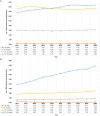Trends in antipsychotic use among children and adolescents in Germany: a study using 2011-2020 nationwide outpatient claims data
- PMID: 38148746
- PMCID: PMC10749930
- DOI: 10.3389/fpsyt.2023.1264047
Trends in antipsychotic use among children and adolescents in Germany: a study using 2011-2020 nationwide outpatient claims data
Abstract
Introduction: We aimed to provide an update on trends in antipsychotic (AP) use among children and adolescents in Germany.
Materials and methods: Based on nationwide outpatient claims data from Germany, we conducted a cross-sectional study. For each year from 2011 to 2020, we determined the prevalence of AP use, defined as the proportion of children and adolescents with at least one AP dispensation. We evaluated trends in AP use by age, sex, and AP class (typical vs. atypical). Additionally, we assessed trends in the specialty of AP prescribers and the frequency of psychiatric diagnoses among AP users.
Results: Overall, data from more than 12 million children and adolescents were included for each calendar year (2011: 12,488,827; 2020: 13,330,836). From 2011 to 2020, the overall prevalence of pediatric AP use increased from 3.16 to 3.65 per 1,000, due to an increase in use of both typical APs (from 1.16 to 1.35 per 1,000) and atypical APs (from 2.35 to 2.75 per 1,000). The largest increase in AP use was found among 15- to 19-year-old females, with an increase from 3.88 per 1,000 in 2011 to 7.86 per 1,000 in 2020 (+103%), mainly due to rising quetiapine use (from 1.17 to 3.46 per 1,000). Regarding prescribers' specialty, the proportion of APs prescribed by child and adolescent psychiatrists increased during the studied period (2011: 24.8%; 2020: 36.4%), whereas prescriptions by pediatricians (2011: 26.0%; 2020: 19.9%) and general practitioners (2011: 18.0%; 2020: 12.4%) decreased. Risperidone was the most commonly used AP in males, and quetiapine was the leading AP in females, each with the highest prevalence in 15- to 19-year-olds. In male risperidone users in this age group, the most frequent diagnosis was attention-deficit/hyperactivity disorder (50.4%), while in female quetiapine users it was depression (82.0%).
Discussion: Use of APs among children and adolescents in Germany has continued to increase over the last decade. The sharp increase in AP use among 15- to 19-year-old females, which is largely due to an increased use of quetiapine, is remarkable. Potential reasons for this increase-e.g., limited access to psychosocial treatments-should be carefully analyzed. Also, the introduction of more restrictive prescribing guidelines might be considered.
Keywords: adolescents; antipsychotics; children; pediatrics; pharmacoepidemiology; psychiatry.
Copyright © 2023 Dörks, Bachmann, Below, Hoffmann, Paschke and Scholle.
Conflict of interest statement
The authors declare that the research was conducted in the absence of any commercial or financial relationships that could be construed as a potential conflict of interest.
Figures




References
LinkOut - more resources
Full Text Sources
Miscellaneous

